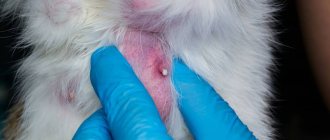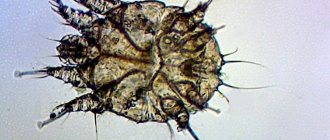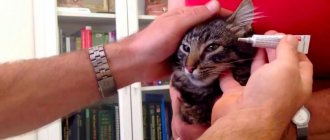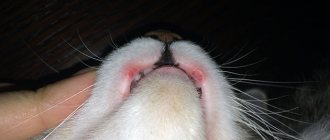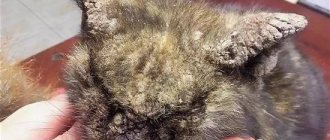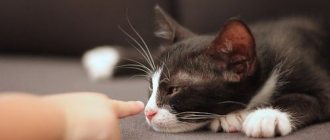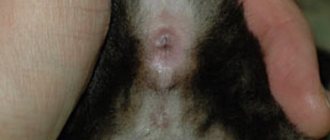What to do if roundworms ? Unfortunately, our little brothers have a huge number of diseases and there are far no fewer of them than people. There is only one problem: the pet is simply not able to say what hurts and in what place
. The only thing he is capable of is to send signals for help to the only one he trusts - the owner. The owner’s task is to recognize the symptoms and immediately contact a veterinarian for professional help and call him at home.
If you go to the clinic with a sick animal, especially a cat, on your own, then the anxiety and stress that she will experience will not turn out for the best. This puts cats at risk of developing the existing disease and developing new infections. After all, the immune system has weakened and is unable to defend itself. In particular, it is not able to protect itself from parasites, for example, roundworms - a common type of worms, which we will talk about in this article. Moreover, you should not carry out treatment yourself without consulting an expert.
Our veterinary center provides a veterinarian home call service. The final price will be announced immediately over the phone. The veterinarian will ask a number of questions, the answers to which will help him formulate an approximate diagnosis and the cause of the bad symptoms even during the departure. This means that upon arrival, he will prescribe the correct course of treatment much earlier, since the examination will take less time. In any disease, especially a parasitic one, time plays an important role, so if you notice any of the symptoms that will be discussed further, consult a doctor!
Who are roundworms - Ascariasis in cats
Roundworms are dioecious roundworms that are characterized by sex differences in size. Females are usually much larger than males. Most often, roundworms infect the gastrointestinal tract of cats, although some species can colonize the bile ducts and pancreas.
Cats are characterized by 3 types of roundworms:
- Toxocara leonine - females usually reach 10 centimeters in length, and males - 6 cm. The body has a yellowish tint. And the head section is equipped with lateral wings and has three lips. It has a simpler cycle, unlike Toxacara catti. The eggs are excreted from the body of the main host (cat or dog) along with the feces, within 4 days it “matures” - at this time the larva inside moults, thus the egg becomes active for infection. Then the eggs can directly enter the cat’s body, or by eating an intermediate host - a rodent. Not dangerous for people.
- Toxocara mystax or Toxacara catti - The main causative agent of ascariasis (toxocariasis) in cats. Males are usually much smaller than females - from 3 to 6 cm, while females are more than 10 cm. To reach sexual maturity, the parasite migrates in the cat’s body and spreads from the intestines to the lungs and liver, and also damages other organs. From the trachea, the larvae, when coughed, again enter the digestive tract and complete the cycle. Dangerous for humans.
- T. canis affects not only dogs, but can also parasitize the intestines of cats. The development cycle completely repeats that of the feline Toxocara. It is also dangerous for humans, although it does not undergo a full cycle in the body; humans are intermediate hosts.
The main danger of roundworms is their high contagiousness. When the soil is infested with eggs, they can persist for several years, becoming a source of disease.
Life cycle
On average, it takes approximately 14-20 days from egg to maturity. The roundworm Toxocara cati is considered the most common; below we will talk in more detail about their life cycle.
The definitive host plays a significant role for these intestinal worms. In intermediate stages, roundworms can live in beetles, mice, grasshoppers and chickens.
When the eggs enter the gastrointestinal tract, larvae then develop from them. Their size usually does not exceed half a millimeter. After this, they independently penetrate the bloodstream, so the infection spreads throughout the body.
The body tries in different ways to remove parasites at the development stage, so a large amount of sputum is formed. But this method of struggle does not help, and a large amount of sputum causes the pet to have difficulty breathing.
In the cavity of the small intestine, the parasites already develop into a sexually mature individual. When roundworms develop, they are capable of releasing an incredibly large number of eggs into the animal's feces. Scientists have calculated that approximately 1 g of feces can contain up to 120 thousand future worms.
Causes
Ascariasis in cats. The main route of transmission is through soil, food, grass, and furnishings contaminated with worm eggs. Parasites can get on the animal's fur and settle in the intestines through licking.
Another alternative route of infection is an intermediate host. In them, roundworms cannot reach sexual maturity and are encapsulated in the nervous system and muscles. A cat becomes infected by eating an infected animal. Rodents, earthworms, frogs, pigs, birds and sheep can act as intermediate hosts.
If the female is pregnant, then infection of the offspring occurs through the umbilical vein directly into the lungs. There, the parasites enter the kittens' trachea, subsequently migrating into the intestines and completing the maturation process. This method of infection is typical for canine toxocara, while Toxacara catti does not infect the fetus.
Toxocara also infects offspring during breastfeeding, entering the intestines through milk.
One infected cat per day can excrete about 100,000 eggs in feces, which are contained in just 1 gram of feces.
Ways to infect cats
Roundworms are very tenacious parasites that live almost everywhere. This is one of the most common types of parasites, so if an owner is wondering whether his cat might have roundworms, the answer will always be positive.
Even a cat that has never left the apartment or been outside can become infected with this disease.
Here are the main ways to infect cats with roundworms:
A pet easily becomes infected with parasites from its relatives. The fur of cats infected with certain types of roundworms always contains a lot of their eggs, which quickly infect other animals and humans.
If the owner was in a house where a cat infected with parasites lives, there is a considerable chance of bringing roundworm eggs to his pet on his clothes or hands. In some cases, you can even bring parasite eggs from the street on your shoes.
Often infection occurs with food; for example, larvae can survive on a piece of meat that has not been cooked long enough. For cats walking outside, the risk of getting sick is even greater - rodents are often carriers of toxocariasis.
Kittens become infected with the disease from their mother, and toxocariasis is especially dangerous for them.
Fleas not only bring discomfort to cats, but also carry the eggs of parasites, including roundworms.
Seizures in cats - main causes, symptoms, first aid, treatment and choice of drugs (110 photos)Polycystic kidney disease in cats - causes, diagnosis and symptoms of the disease. Treatment options and prevention of kidney disease (95 photos)
Tartar in cats - signs of the disease and methods of fully treating tartar (125 photos + video)
Symptoms - Ascariasis in cats
Ascariasis in cats. In adults, toxocariasis rarely causes symptoms of the disease. Mostly, signs of the disease appear in kittens. Typically characterized by stunted growth and lack of weight, an enlarged abdomen and dull coat.
The offspring also develop:
- Anemia, expressed in pallor of the mucous membranes and skin.
- Diarrhea and vomiting. Blood may be found in the stool.
- Possible increase in temperature.
- Itching of the anus, due to which the cat will constantly lick it.
Due to the migration of larvae, cats may experience complications due to damage to internal organs:
- Pneumonia.
- Ascites.
- Peritonitis.
- Cough (due to the release of larvae into the trachea).
- Liver damage.
If there are a large number of parasites, the kitten may develop intestinal obstruction, causing constipation. The bile ducts are also blocked, leading to obstructive jaundice.
About the pathogen
Ascariasis is caused by a parasite called human roundworm or Ascaris lumbricoides. It is called human not because of its humanity and humanity, but for the simple reason that it can live exclusively in the human body. Ascaris will not survive either in the body of a dog, or in the body of a cat, cow or horse.
Ascaris is a roundworm. In general, it does not have a single organ or appendage with which it could attach to organs, and therefore, unlike many other worms, it does not choose habitats in the child’s body, but constantly travels, moving towards food masses. The roundworm is almost devoid of sense organs, there is only touch, which is responsible for the small tubercles around the mouth of the worm.
The roundworm lives in the lumen of the small intestine. These are very impressive parasites in size: an adult female can reach 40 centimeters in length, and a male can reach 25 centimeters. Parasites reproduce sexually, and every day a fertilized female can lay up to a quarter of a million eggs, which are released with the contents of the intestines.
Nature has taken great care of the offspring of roundworms - the eggs are “equipped” with shells that have 5 layers, which make them almost invulnerable to the influence of the external environment. Neither cold, nor chlorine, nor other disinfectants threaten them.
Before finding a new host, the eggs mature in the ground. The warmer the climate in the region, the faster the eggs mature. There are cases where they remained alive and potentially dangerous even after 12 years in the ground.
Roundworms remain “faithful” to their host; they do not change it throughout their entire life. As soon as unfertilized eggs penetrate into the child's body from the soil with dirty vegetables or fruits, having been carried by flies and other unpleasant insects, larvae emerge from them in the intestine, which are able to enter the blood vessels through the intestinal wall, from there into the liver, into the right atrium , lungs. The child begins to cough, and the larvae with mucus move into the pharynx, are swallowed again, and again end up in the small intestine, where they mate and lay eggs. This is a complete life cycle.
The migration phase from the intestines to the lungs through the bloodstream takes up to two weeks. Sometimes young larvae manage to cover the entire path in 8 days. The subsequent intestinal stage after secondary ingestion is the longest. It can last about a year; the first “fresh” eggs begin to appear in the child’s stool within a couple of months after infection.
What the roundworm feeds on is known to science in some detail: at first it is blood serum, but as it grows older, the serum becomes scarce, and the individual begins to consume red blood cells - erythrocytes. The choice is not accidental - roundworms also need oxygen, and these are the cells that carry it. The older the roundworm gets, the more oxygen it needs, which is why individuals devoid of intelligence intuitively strive to where there is the most oxygen - into the lungs.
The insidiousness of roundworms lies in the fact that they do not always clearly follow the phases of the life cycle provided by nature. Individuals can linger in the liver or lungs, causing serious pathological processes there. Over time, they are distributed throughout the body and can affect the pancreas, gallbladder and bile ducts, heart, and brain.
It is noteworthy that roundworms also have benefits. Researchers from California discovered their phenomenal ability to increase women’s fertility. They found that the presence of roundworms in a woman’s body increases the chances of conceiving and bearing a child.
Signs of roundworms in cats
Ascariasis in cats. In order not to miss toxocariasis in a pet, the owner must be attentive to its well-being and condition. There is a list of signs by which one can suspect a helminthic infestation in a beloved cat:
- decreased activity of the animal - it sleeps a lot or lies motionless;
- growth and development delay in young animals;
- dull and falling out fur;
- thinness against the backdrop of a “brutal” appetite;
- periodic indifference to food;
- disproportionately large abdominal volume, as with bloating;
- worm eggs on the animal’s “pants” and around the anus, which is most noticeable when the fur is long and dark;
- pale tint of mucous membranes is one of the signs of anemia;
- vomiting and diarrhea, sometimes with blood and worms;
- persistent itching in the anal area, which causes anxiety in the animal and leads to the cat aggressively licking the anus.
Are there any complications?
I have repeatedly come across the opinion that after administering antiparasitic drugs, the animal shows signs of poisoning, even death. Yes, the drugs cannot be called non-toxic, but there are still no serious side effects.
Problems usually arise in the event of an erroneous dosage or an incorrectly selected drug. In turn, deaths also occur, but they occur only with a strong degree of invasion, when poisoning occurs not due to chemistry, but as a result of a massive release of toxic substances into the blood, secreted by dead helminths.
An even more rare occurrence is an allergic reaction, but in this case the cat can be protected by additionally prescribing antihistamines if the animal is prone to allergies.
How dangerous is ascariasis for cats?
Roundworms in cats cause the chronic disease toxocariasis. In principle, even the name “roundworms” for roundworms that parasitize the body of cats and dogs is not entirely accurate. Toxocara leonina, Toxocara mystax, Toxacara catti live in the intestines of cats and dogs. You can see how they look in the photo. These parasites belong to the general suborder of roundworms (nematodes) Ascaridata of the genus Ascaris. It has been clinically proven that roundworms in cats and dogs cannot cause helminthic infestation in humans.
Ascariasis in cats. Dog or cat roundworm eggs will not be able to develop in the human body, even if they are purposefully “planted” there. This is due to the fact that human roundworm develops in the intestines at a temperature of 36.6 degrees, and roundworms of cats and dogs develop at a temperature of 38.5 - 39 degrees.
A person can become infected with other worms from animals, so pets need to undergo a full course of deworming once every 3 months, and if a helminthic infestation is diagnosed, they need adequate treatment.
Is there immunity against worms?
Some animals are born immune to certain worms and similar parasites. Most likely this is due to a strong developed immune system, which fights parasites particularly effectively. However, this does not guarantee complete protection from external parasites.
The body's defenses are capable of squeezing out the parasite on its own.
, therefore, there is a possibility and probability that even after some symptoms and signs, they pass and the worms die.
The main thing to consider
– keeping a cat, feeding it, diet, as well as physical activity. Only such a pet is able to resist any diseases and parasites and, with a little help from medications, quickly come to its senses and, perhaps, even go through its entire life without a single disease.
Ways of infection of pets
Ascariasis in cats. Even if your pets are constantly at home, the possibility of ascariasis in cats cannot be ruled out. An animal may “just for a second” jump out onto the landing, or may sniff and lick your outdoor shoes, which almost always contain worm eggs.
Puppies and kittens can ingest eggs in their mother's milk or become infected in utero from a sick mother. Before mating, animals must undergo anthelmintic treatment.
With the feces of a sick animal, fertilized eggs of parasites fall into the soil, where, under favorable conditions, the maturation process occurs. Microscopic mature worm eggs are carried by flies, ants, and shoes. Gusts of wind during drafts, along with dust, can be carried into the apartment through open windows. It is noteworthy that in direct sunlight the eggs die within a couple of hours, but they can tolerate frost down to -25 degrees, just being on the surface of the earth.
Only regular wet cleaning, disinfection of trays, maintaining a sanitary culture of housing, regular deworming and proper treatment can protect pets from parasites.
Prevalence
Cat Toxocara is found everywhere. The greatest prevalence is observed in settlements with a large number of stray cats. As the results of the study show, more parasite eggs were found in urban soil samples than in rural areas.
In European countries, the number of infected adult cats, according to research from the late 90s of the last century, exceeds 30% (France - 31%, Germany - 45%). In Asia and Africa, this figure is lower (Japan - 18.2%, Somalia - 28%, South Africa - 11%). It is also known that with age, cats are no longer so susceptible to infection - among kittens the percentage of patients is much higher.
Are roundworms in cats transmitted to humans?
Quite often, when we see an infected animal, we reflexively scare it away, fearing infection. This is one of the most popular myths. The opinion that roundworms in cats are transmitted to humans turns out to be erroneous.
The fact is that round intestinal worms in animals do not take root in the human body. There is an opinion that large roundworms in the body of a pig can take root in humans, but this has not yet been proven by science. The very way of infecting a person with worms is as follows: viable eggs can enter the body only through the soil, and only from person to person.
Prevention
There are measures to help prevent infection with worms:
- Timely deworming, which is carried out at least once every six months;
- Avoiding contact between the person in your care and shoes;
- Do not allow birds and rodents to diversify the animal’s menu, do not use raw fish or meat that has not undergone heat treatment;
- Care for the litter box regularly;
- Limit free access to the street;
- Treat against insects;
Drinking water should be clean and changed frequently.
If you carefully follow all preventive requirements, then, most likely, treatment for roundworm in cats can be avoided.
Danger to humans
Ascariasis in cats. Although the worm cannot undergo a full sexual cycle in the human body, it can still act as an intermediate host. Once in the intestines, the larvae migrate to the muscles, central nervous system, eyes, liver, lungs and heart. There the larvae are encapsulated.
Toxocariasis is especially dangerous for children, in whom it can cause serious complications and lead to death.
Basically, the disease in people manifests itself with vomiting, diarrhea, and a sharp increase in temperature. Depending on the affected organ, decreased vision and anorexia can be observed.
Due to the high fertility of parasites, eggs can reach a person even after stroking a pet. Therefore, washing your hands after playing with your pet is strictly necessary!
Among all cases of infection, the largest percentage accounts for Toxacara canis, while feline roundworms occur in isolated cases.
How and why does infection occur?
Toxascariasis in cats is provoked by 3 types of toxocara - cati, canis and leonina. Parasites belong to the class of nematodes (roundworms) and reach up to 20 cm in length, have a color from pale yellow to light brown. On the head of the worm there is a mouth opening with teeth, with which the worm damages the mucous membranes and penetrates into the organ. Most often they parasitize in the small intestine. However, they can migrate with the bloodstream and settle in the lungs, brain, and organs of the genitourinary system. The most dangerous worms are in kittens under 3 months of age, when death can occur due to toxins secreted by the worms.
The cat swallows the egg, from which the larva hatches in the body. Invading organs, roundworms damage the mucous membranes, feeding on the beneficial substances of the cat's body. Infection in kittens occurs through a sick mother. Animals become infected in this way:
Helminth eggs can enter the animal's body when it licks itself.
- accidental ingestion of parasites in contaminated water;
- communication with a sick animal;
- presence of fleas;
- eating rodents;
- inhalation of larvae;
- introduction of helminth eggs by the owner with street clothing;
- infection when washing, when the cat licks itself.
Diagnostics - Ascariasis in cats
The main diagnostic method is to examine stool for worm eggs. It is necessary to carry out three samplings to exclude weak infestations. Tests are carried out at intervals of 10 days, during which time the helminths will be able to reach sexual maturity and begin to secrete eggs.
In rare cases, adults can be found in it. Worms are also found in vomit.
It is advisable to perform an ultrasound of the abdominal cavity to exclude blockage of the intestinal lumen and bile ducts. X-rays can also be taken using barium contrast.
How to diagnose the presence of roundworms?
To do this, it is necessary to submit a sample of the animal’s feces for analysis three times, at intervals of 10 days. Diagnostics will take almost a month, but it is necessary, since a single collection of biomaterial can show signs of mild infection, while within twenty days from the first visit to the veterinary clinic the next generation of helminths will “hatch”. Feces for research are delivered to the laboratory by the owner of the animal in special containers.
Bloating in a cat infected with roundworms
If a significant amount of parasites is suspected in the digestive tract, an ultrasound of the abdominal organs is performed. Among other things, this allows you to assess intestinal permeability and the condition of the biliary tract. Sometimes, instead of an ultrasound, X-rays using barium contrast are done.
The sooner the owner detects a disease in the cat, the higher the chance of saving it.
When there are signs of the presence of roundworms not (or not only) in the intestinal tract, the animal is prescribed a blood and urine test, as well as an ultrasound of the relevant organs. Based on the diagnostic results, treatment is prescribed.
Treatment
Ascariasis in cats. Therapy for toxocariasis is as simple as for most helminths. Usually used anthelmintics - pyrantel, albendazole. These drugs cause complete paralysis of adult worms and have a detrimental effect on eggs and larvae.
Drug dosage regimen:
- Pyrantel – 5 mg per kg of body weight orally once.
- Azipirin – 0.5 tablets once.
- Levamisole – 7 ml per kg subcutaneously.
Therapy is repeated 2 weeks after the first dose.
If there is a deterioration in the kitten’s condition, they may be prescribed Gamavit, an infusion of infusion solutions. In case of massive invasion, antihistamines and corticosteroids can be used to relieve intoxication.
If there is a blockage in the intestines or bile ducts, surgery is performed.
Be sure to sanitize the cat's bowl, drinking bowl, tray and bed. All blankets and blankets on which the cat sleeps should also be treated with disinfectants. Wash floors and surfaces.
Treatment for humans
Ascariasis in cats. Usually, treatment for ascariasis caused by cat or dog Toxocara is not required; the disease goes away on its own over time. The exception is damage to the eyes and central nervous system. Antihelminthic drugs are also used, and surgical removal of parasites is possible.
Treatment and prevention of toxocariasis and toxascarosis
Severe infestation can be eliminated with the help of conventional anthelmintic or endoectocidal drugs, for example, for this you can use the complex drug Nexgard Spectra
To control the spread of Toxocara eggs and their spread in the environment, it is advisable to prevent the development of infestations through regular preventive deworming treatments for dogs.
The approved indications for T. canis should be taken into account when selecting an appropriate anthelmintic drug.
In addition to deworming, the risk of contamination of the environment with eggs can be reduced through preventive measures, including feeding the animal with heat-treated food or ready-made feed rations, as well as collecting and disposing of feces.
Popular medications for worming in cats
If someone tried to view and compare instructions for deworming products for cats, they noticed that almost all tablets usually contain two substances:
- one of which acts on roundworms (usually piperazine, pyrantel, fenbendazole, milbemycin or emodepside),
- and another is effective against flukes and tape parasites (praziquantel).
Therefore, trying to identify something extraordinary and super-effective among them is quite difficult, since their chemical substances are basically the same and they work against the same helminths:
- Tohosaga cati,
- Ancylostoma tubaeforme,
- Ancylostoma braziliense,
- Echinococcus granulosus,
- Echinococcus multi-locularis,
- Dipylidium caninum
- Taenia spp.,
- Mesocestoides spp.,
- Joyeuxiella sp.
This group of universal products with the same set of active ingredients includes:
- drontal - tablets, used from three weeks of age;
- Profender - drops, approved for use from five weeks of age,
- prazicide - suspension, not recommended for babies under three weeks of age;
- pratel - tablets;
- troncil K - used for kittens from 3 weeks;
- febtal - tablets based on fenbendazole;
- kaniquantel - used for cats and kittens starting from three weeks;
- milbemax (not earlier than six weeks of age) - it is worth highlighting because the active substance (mibelmicin oxy) against nematodes not only kills intestinal helminths, but also acts on dirofilaria, which live in the bloodstream and heart of the animal.
Unlike these drugs, polyvercan is based on other active principles: niclosamide (cestodic action) and oxybendazole (anti-nematode), but at the same time it also retains the title of a broad-spectrum anthelmintic.
In pharmacy kiosks you can find another antiparasitic drug in the form of drops - Inspector, which not only has anthelmintic properties, but can also simultaneously act on fleas and ticks, which is very convenient: you can get rid of all parasites in one go. It contains two chemicals:
- Fipronil is an excellent insecticide that, after application to the skin, tends to accumulate in its lubricant and hair follicles. Released over a long period of time, it ensures long-lasting activity. It is not recommended for use in kittens under 3 months of age, as well as in sick and old animals, due to possible negative consequences;
- Moxidectin belongs to the group of avermectins, but unlike ivermectin, it does not cause signs of poisoning in cats, even with an overdose. Works well against roundworms and is an excellent means of preventing dirofilariasis. If the test for microrofilaria and adults is positive, it is prescribed with caution, due to the high probability of the animal dying from intoxication as a result of the decay of helminths.
Recently, information has appeared that the drugs drontal, prazitel, and prazitid are often counterfeited, so you should be careful with their use. Not only will these remedies not rid your cat of worms, but they can also be fatal. Therefore, if you are not sure of the quality of the medicine, and the veterinary pharmacy does not have a license for it, then it is better to refuse such a dubious purchase.
How to treat your pet?
For therapy, highly effective antiparasitic drugs are used, which not only get rid of adult worms, but also destroy the larvae. It is important that the medications are not dangerous for the cats themselves, and some are even approved for use in kittens in the first month of life. The following products are especially popular among veterinarians and animal owners:
"Kaniquantel plus"
These tablets smell and taste like meat and are considered one of the best anthelmintic drugs. They allow you to fight several types of intestinal worms simultaneously and have a minimum of side effects.
Thanks to its smell, “Kaniquantel plus” is easily eaten by cats
It is important that it is not difficult to “persuade” your pet to eat the medicine - cats take such tablets as a treat and gobble them up with pleasure. For maximum effect of the drug, a single dose is sufficient. The tablets are approved for the treatment of kittens that are 3 weeks old.
"Milbemax"
Another combined anthelmintic drug, which has meat “signs” that are pleasant for cats, greatly facilitates the use of the drug. Milbemax is sold in tablets with different concentrations of the active substance. This allows you to choose the best option taking into account the age and weight of the animal.
Side effects of Milbemax are minimal and disappear within 24 hours
For babies six weeks of age, with a body weight of 500 g, and adolescent animals, “Milbemax for kittens and young cats” is indicated. For older people there is “Milbemax for adults”. Calculating the permissible amount of the drug is not difficult thanks to the simple and detailed instructions for the drug.
Important! Despite the fact that the medicine is usually well tolerated by cats, in some cases trembling of the limbs and general lethargy may occur.
"Prasitel"
An excellent remedy for toxocariasis, approved for use in animals 3 weeks of age. Babies are given a suspension, and for adults Prazitel is released in tablet form.
A single dose of Prazitel is usually enough for a cat to recover
You should feed the medicine to your pet once, adding it to your favorite treat, usual food or drinking water. In case of advanced toxocariasis, it is recommended to take Prazitel again 10 days later.
"Drontal"
An anti-worm remedy that allows you to get rid of nematode parasites (roundworms) and taeniasis (tapeworms). Prescribed at the rate of 1 tablet per 4 kg of animal weight. It is recommended to give the medicine to your pet once, during morning feeding, with its usual food.
Before using Drontal, it is advisable to consult a veterinarian, since intolerance is possible.
If the animal does not have a history of hypersensitivity to the components of the drug, then taking it in recommended doses does not cause side effects.
"Dironet"
Dironet is a line of anthelmintic drugs for cats and dogs. Sold in the form of tablets and suspensions, separately for each type of animal. Effective against round and tape parasites. Additionally, they are available: “Dironet Junior” for kittens, as well as a drug with a brand name in the form of drops for application to the withers. The suspension smells like fresh salmon and is used in a dosage of 1 ml per 1 kg of cat’s body weight.
Important! Each of the Dironet tablets is designed for 10 kg of pet weight, therefore Dironet in the form of tablets is recommended exclusively for adult cats of large breeds (for example, Maine Coons).
Dironet may not be suitable for breeds with small dimensions and low weight
In cases where the cat completely refuses to swallow the tablets, they are sometimes replaced with external drops such as Stronghold. Such drugs act more slowly, their concentration in the digestive tract will be less compared to tablets and suspensions.
Stronghold drops are suitable for uncooperative cats, but you should be prepared for the fact that their effect is less than that of tablets
For this reason, it is better to use drops when it comes to the prevention and treatment of helminthic infestation in the initial period. When it comes to a large-scale parasite attack, it is better to choose medications administered orally (through the mouth).
Regardless of whether your pet has had roundworms, it is advisable to periodically disinfect your cat’s accessories.
During treatment, care must be taken to ensure that all household items used by the cat are disinfected:
- bowls for food and water;
- pet tray and toys.
In addition, it is recommended to periodically use antiseptic solutions during wet cleaning of premises. If there are other cats and dogs in the family, you will also have to check them for the presence of worms and, if necessary, treat them.
